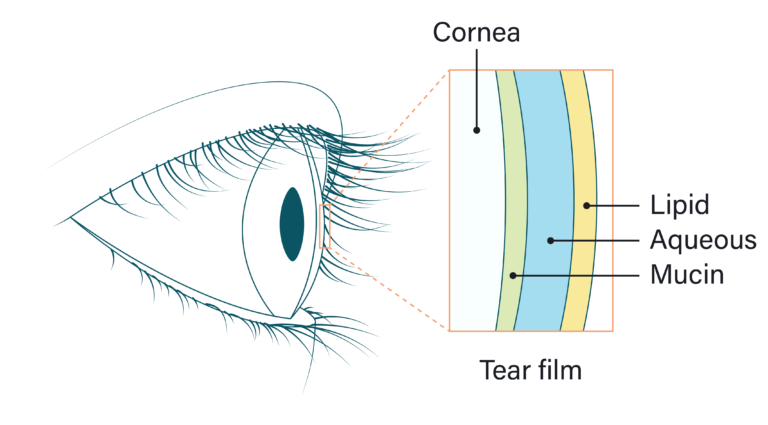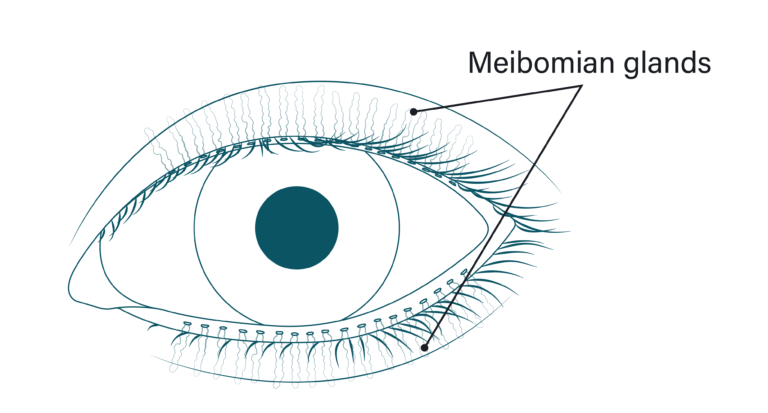Dry Eye Disease
Tears are more than just displays of emotion. They’re crucial for the health and comfort of ours eyes. They provide lubrication, nourishment, and protection to the cornea (the clear front surface of the eye). If there’s decreased tear production because of things like aging, medications, or medical conditions or the quality of the tear film is poor, it can result in dry eye disease.
Common symptoms of dry eye are a burning or stinging sensation, feeling like there’s something in the eye, blurred or fluctuating vision, sensitivity to light, and redness.
Many things can cause or increase the risk of dry eye including aging, blepharitis, weather changes, vitamin A deficiency, and medical conditions like leukemia, lymphoma, Sjogren syndrome, and rheumatoid arthritis. Patients who have corneal ulcers, eye infections, laser vision correction, or eyelid/facial surgery are also likely to have/develop symptoms.
Dysfunctional Tear Syndrome (DTS)
Dysfunctional tear syndrome (DTS) occurs when the tear glands don’t produce enough tears or when the tear film evaporates causing the eyes to feel itchy, scratchy, and irritated. DTS affects a significant percentage of the population, especially those older than 40 years of age because tear production decreases with age. It affects any race but is more common in women than in men. It can also be associated with blepharitis (inflammation of the eyelid margins), arthritis, lupus and other inflammatory diseases or disorders. It’s very common after eye surgeries and with glaucoma drops. Before testing for surgery, DTS must be treated otherwise dry eye can alter measurements and the outcome of the surgery.
Meibomian Gland Dysfunction (MGD)
The tear film covers the surface of the eye (cornea) and keeps it lubricated. Tears consist of three layers: a mucous inner layer (mucin), a watery middle layer (aqueous), and an oily outer layer (lipid) to keep all that moisture trapped.
The meibomian glands (MG) are located in the eyelids and are responsible for producing the oily layer. When the glands fail to produce or secrete the oil properly (due to a blockage or because the oil is too thick), it affects the quality of the tear film. This results in classic dry eye symptoms because without the oil to trap the moisture, the watery layer evaporates too quickly and can no longer keep the eye moisturized.
MGD is quite common and unfortunately it often goes undiagnosed. Even when diagnosed is often not treated or is not treated effectively until it has become chronic or severe. MGD may be inflammatory (often as a result of blepharitis).


Demodex Blepharitis
Blepharitis is inflammation of the eyelids, typically along the edges. It can be caused by blockages in the oil glands near the base of the eyelashes resulting in irritation, dry eyes, and redness.
Demodex are tiny mites that live on human skin in hair follicles and oil glands. While they’re common in small amounts, when they overpopulate it can result in a form of blepharitis called Demodex blepharitis as well as other eye conditions like meibomian gland dysfunction (MGD) and conjunctivitis. Sometimes if a patient is diagnosed with dry eye but they are not responding to treatment, it might be the overlooked Demodex blepharitis.
Patients with Demodex blepharitis will feel early morning itching and irritation because of the Demodex’s aversion to light. The mites prefer to frolic at night to eat dead skin cells and lay their eggs in eyelid glands and on eyelash follicles then crawl back into the follicle in the morning causing the itching.
Treatment
Tea Tree Oil
We recommend using special lid wipes formulated with 5% tea tree oil such as the I-LID ‘N LASH® PLUS (can be purchased at PVSC). Lids and lashes should be cleaned every night before going to bed. Make sure you are wiping vigorously to get the oil into the lash roots and along the lashes to kill any eggs. For instructions on how to use, click here.
If the I-LID ‘N LASH® PLUS is not working with consistent use, at PVSC we can perform a professional cleanup using the I-LID ‘N LASH® PRO (20% tea tree oil for professional use only) and the BlephClean.
Patients must also institute an eye hygiene regimen at home.
- Use tea tree shampoo for the hair and eye lashes every day
- Use tea tree soap or face wash every day
- Women should throw out makeup and not use any new makeup for a week
- Clean sheets and/or buy new pillows
- Ensure their partner is checked for mites
- Have any pets that sleep on the bed checked
- For the first few weeks, patients should use tea tree ointment at night after the shampoo scrub at home
BlephaClean
BlephaClean is an in-office procedure performed at PVSC in which a revolving handpiece is used to carefully spin a cotton tip along the edge of your eyelids and lashes, removing scurf and debris and exfoliating your eyelids. It’s a painless vibration sensation but a freezing drop is usually placed in each eye prior to treatment for increased comfort. The procedure lasts about 5 minutes and, for Demodex infestations, is usually repeated every week for 3 weeks using tea-tree oil (TTO) to control the infestation.
